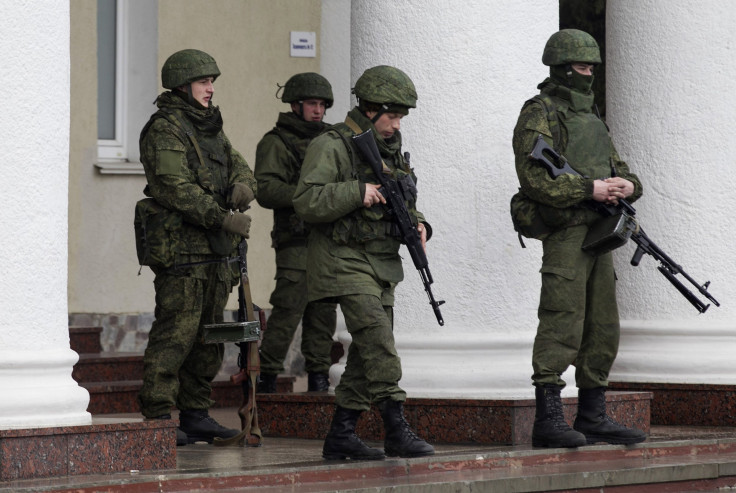Russia's Use Of Unmarked Troops In Simferopol, Crimea: Shady, But Not Illegal

“Armed men of uncertain allegiance,” the New York Times called them in a dispatch from Simferopol, on Feb. 28: “Their military uniforms bore no insignia and it was not clear who they were or who was commanding them.”
They were the mysterious figures who last Friday surrounded the main airport in Crimea, the Ukrainian autonomous region at the center of a standoff between Russian and Ukrainian forces that could escalate into war soon.
But journalists on the scene didn’t take long to identify them as Russian soldiers. After all, elsewhere in Crimea armored personnel carriers with Russian insignia, as well as men wearing the uniform of the Russian Black Sea Fleet, had appeared. The Ukrainian air force base at Belbek had been surrounded by Russian soldiers.
According to a Facebook post by Ukraine’s interior minister, Arsen Avakov, quoted by several Western media outlets, the men blocking the Simferopol airport may not have carried identifying insignia, but did not “hide their affiliation.”
So, what was happening on the ground was clear: The Russians were taking over Crimea, although for now they have done so peacefully. The only shots reported so far have been Kalashnikov bursts in the air, fired by the soldiers surrounding Belbek as a warning to an approaching group of unarmed Ukrainians.
But legally? Were the Russian troops in Simferopol acting outside of international law by not wearing insignia that identified their nation -- especially as the Kremlin reiterated over the weekend that it had not moved into Crimea? Was Ukraine’s president Oleksandr Turchynov justified in calling the men in Simferopol “terrorists with automatic weapons, judged by our special services to be professional soldiers”?
Whatever one’s position on Russian president Vladimir Putin’s gambit in Crimea, one thing is clear: Using unmarked troops to conduct military operations is not, per se, illegal.
International law is a collection of customary rules and binding agreements through treaties, and by sending soldiers into Ukraine without displaying its flag, Russia may be acting shadily, but is not violating either.
“Article 4 of the Third Geneva Convention says you have to wear symbols recognizable at a distance, but they do not need to indicate national origin,” Gary D. Solis, a law professor at Georgetown University who specializes in the laws of war, explained.
The point of the Geneva Conventions in this case is to enforce the principle of distinction between civilians and military combatants, so that civilians are not targeted. Article 48 of the Additional Protocol I to the Conventions states that “in order to ensure respect for and protection of the civilian population and civilian objects, the Parties to the conflict shall at all times distinguish between the civilian population and combatants and between civilian objects and military objectives and accordingly shall direct their operations only against military objectives.”
In other words, if someone is obviously an armed soldier in a conflict, international law treats him or her as such. “There is not an obligation in international humanitarian law to wear” uniforms, wrote Toni Pfanner, editor in chief of the International Review of the Red Cross, in a 2004 paper entitled Military Uniforms and the Law of War. The troops in Simferopol may not have been obviously identifiable as Russian, but they were clearly armed personnel in military garb, and as such, they were not violating the obligation that they should not be confused with civilians.
Not that the situation in Crimea has reached the point where the Geneva Conventions would even come into play. “So far the law of armed conflict does not apply at all, insofar as there hasn’t been a shot fired,” Solis said. “I assume sooner or later there will be shooting, but as long as the civilians are distinguishable from the combatants the laws of armed conflict are complied with.”
But if Russia went into Crimea with the intention of showing force, would it not have made more sense to actually show its colors, rather than hide them? Not necessarily, Solis said, referring to an editorial by former U.S. national security adviser Zbigniew Brzezinski, who wrote Tuesday in the Washington Post that “Putin went in masked like a Mafia gangster.” The reason was that “in the event of serious Ukrainian resistance, he could disown the initiative and pull back,” wrote Brzezinski.
Images from Maidan Square in Kiev and elsewhere in Ukraine have shown also the reverse issue: Some civilians on the barricades looked like soldiers. Possibly because they kept their military-issue clothing after serving as conscripts -- the country had a draft system until the end of last year -- many Ukrainian protesters appeared fairly indistinguishable from the military. “Civilians are being unwise in wearing military-style gear,” Solis said. “If you assume the trappings of a combatant, you put yourself at risk.”
© Copyright IBTimes 2024. All rights reserved.






















